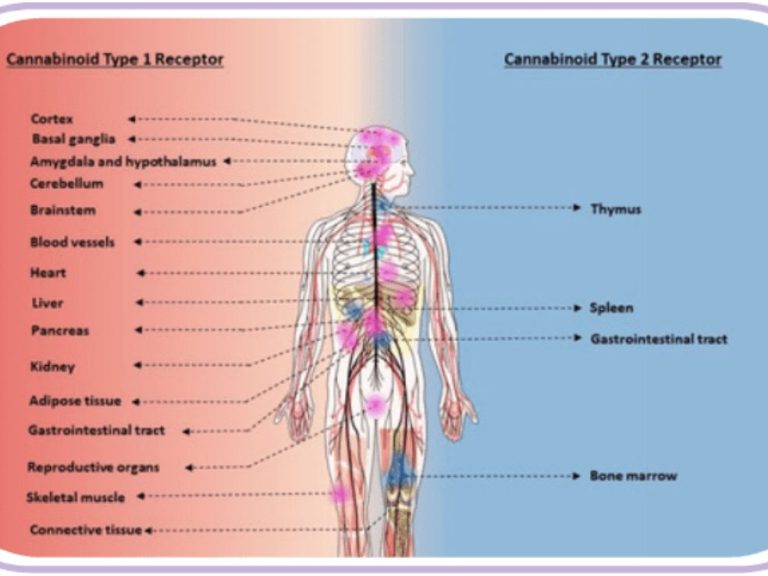The Endocannabinoid System (ECS)
Are We Biologically Wired for Cannabis?
Internal Cannabis Factory
Three main components:
- Endogenous cannabinoids (endocannabinoids) produced by our own bodies
- Cannabinoid receptors scattered throughout our tissues
- Enzymes that synthesize and break down these compounds.
Works Like Lock & Key
THC binds directly to CB1 receptors in the brain, while CBD influences the system more indirectly, affecting how our natural endocannabinoids function and are processed.

Deficiency Theory
Some scientists theorize that certain chronic conditions—including fibromyalgia, migraines, and irritable bowel syndrome are due to a lack of cannabinoids.
Medical Implications
If humans are indeed biologically inclined to interact with cannabinoids, then systematic study of these interactions becomes not just medically relevant but evolutionarily important.
The human body contains a sophisticated network called the endocannabinoid system (ECS), discovered only in the 1990s but now recognized as one of our most important physiological regulatory mechanisms. This system's existence raises a fascinating question: if our bodies naturally produce cannabis-like compounds and have receptors specifically designed to respond to them, does this suggest we're biologically predisposed to interact with external cannabinoids?
The Body's Natural Cannabis Factory
The endocannabinoid system operates through three main components: endogenous cannabinoids (endocannabinoids) produced by our own bodies, cannabinoid receptors scattered throughout our tissues, and enzymes that synthesize and break down these compounds. The two primary endocannabinoids—anandamide and 2-arachidonoylglycerol (2-AG)—function as molecular messengers, helping regulate everything from mood and memory to pain perception and immune response.
What's particularly striking is how precisely plant-derived cannabinoids like THC and CBD fit into this existing biological framework. THC binds directly to CB1 receptors in the brain, while CBD influences the system more indirectly, affecting how our natural endocannabinoids function and are processed.
An Evolutionary Perspective
From an evolutionary standpoint, the endocannabinoid system appears ancient, present in virtually all vertebrates and some invertebrates. This suggests it evolved hundreds of millions of years ago as a fundamental biological process. The fact that plant cannabinoids can so seamlessly interact with this system might indicate a co-evolutionary relationship between humans and cannabis plants spanning millennia.
Archaeological evidence supports this theory. Cannabis seeds have been found in ancient burial sites, and historical records document cannabis use for medicinal and spiritual purposes across diverse cultures for thousands of years. This long relationship suggests that humans and cannabis may have evolved together, with our endocannabinoid system potentially adapting to process external cannabinoids more effectively.
The Lock and Key Phenomenon
The remarkable specificity with which plant cannabinoids interact with human receptors resembles a biological lock-and-key mechanism. This precision is unusual in nature—most plant compounds that affect human physiology do so less specifically. The fact that cannabis compounds evolved to match our receptor sites so precisely suggests either an extraordinary coincidence or a deeper biological relationship.
Some researchers propose that dietary cannabinoids from hemp seeds and other plants may have been part of human nutrition for so long that our systems adapted to process them efficiently. This could explain why many people report feeling a sense of homeostasis or balance when using cannabis products—they may be supplementing a system that evolved expecting such inputs.
Deficiency Theory
The concept of "endocannabinoid deficiency" has gained attention in medical research. Some scientists theorize that certain chronic conditions—including fibromyalgia, migraines, and irritable bowel syndrome—might result from inadequate endocannabinoid production or function. If true, this would suggest that external cannabinoid supplementation could address genuine biological needs, much like how we supplement other deficient systems with vitamins or minerals.
Modern Implications
Understanding the endocannabinoid system's role in human biology doesn't automatically justify recreational cannabis use, but it does provide a framework for considering our relationship with cannabinoids. Rather than viewing cannabis as a foreign substance that artificially alters brain function, we might consider it as a compound that works within existing biological pathways—pathways that appear designed to interact with such molecules.
This perspective has significant implications for medical cannabis research and policy. If humans are indeed biologically inclined to interact with cannabinoids, then systematic study of these interactions becomes not just medically relevant but evolutionarily important.
The Bigger Picture
The endocannabinoid system's discovery has fundamentally changed how we understand human physiology and our relationship with cannabis. While more research is needed to fully understand the implications, the evidence suggests we may be biologically wired to interact with cannabinoids in ways that extend far beyond recreational use.
Whether this represents genetic inclination, evolutionary adaptation, or simply biological compatibility remains an open question. What's clear is that the endocannabinoid system represents a bridge between our internal biology and the external world of plant-derived compounds—a bridge that appears to have been millions of years in the making.
This article presents scientific theories and research findings. Cannabis laws vary by jurisdiction, and medical decisions should always be made in consultation with qualified healthcare providers.
